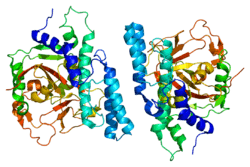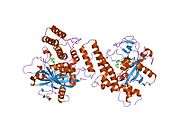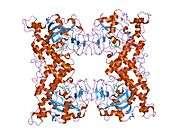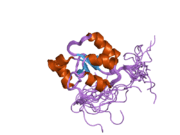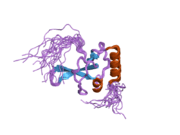PARP1
| View/Edit Human | View/Edit Mouse |
Poly [ADP-ribose] polymerase 1 (PARP-1) also known as NAD+ ADP-ribosyltransferase 1 or poly[ADP-ribose] synthase 1 is an enzyme that in humans is encoded by the PARP1 gene.[5] It is one of the PARP family of enzymes.
Function
PARP1 works:
- By modifying nuclear proteins by poly ADP-ribosylation.
- In conjunction with BRCA, which acts on double strands; members of the PARP family act on single strands; or, when BRCA fails, PARP takes over those jobs as well (in a DNA repair context).
PARP1 is involved in:
- Differentiation, proliferation, and tumor transformation
- Normal or abnormal recovery from DNA damage
- Maybe the site of mutation in Fanconi anemia
- The pathophysiology of type I diabetes.[6]
PARP1 is activated by:
- Helicobacter pylori in the development and proliferation of gastric cancer.[7]
Role in DNA damage repair
PARP1 has a role in repair of single-stranded DNA (ssDNA) breaks. Knocking down intracellular PARP1 levels with siRNA or inhibiting PARP1 activity with small molecules reduces repair of ssDNA breaks. In the absence of PARP1, when these breaks are encountered during DNA replication, the replication fork stalls, and double-strand DNA (dsDNA) breaks accumulate. These dsDNA breaks are repaired via homologous recombination (HR) repair, a potentially error-free repair mechanism. For this reason, cells lacking PARP1 show a hyper-recombinagenic phenotype (e.g., an increased frequency of HR),[8][9][10] which has also been observed in vivo in mice using the pun assay.[11] Thus, if the HR pathway is functioning, PARP1 null mutants (cells without functioning PARP1) do not show an unhealthy phenotype, and in fact, PARP1 knockout mice show no negative phenotype and no increased incidence of tumor formation.[12]
PARP1 over-expression in cancer
PARP1 is one of six enzymes required for the highly error-prone DNA repair pathway microhomology-mediated end joining (MMEJ).[13] MMEJ is associated with frequent chromosome abnormalities such as deletions, translocations, inversions and other complex rearrangements. When PARP1 is up-regulated, MMEJ is increased, causing genome instability.[14] PARP1 is up-regulated and MMEJ is increased in tyrosine kinase-activated leukemias.[14]
PARP1 is also over-expressed when its promoter region ETS site is epigenetically hypomethylated, and this contributes to progression to endometrial cancer,[15] BRCA-mutated ovarian cancer,[16] and BRCA-mutated serous ovarian cancer.[17]
PARP1 is also over-expressed in a number of other cancers, including neuroblastoma,[18] testicular and other germ cell tumors,[19] Ewing’s sarcoma,[20] malignant lymphoma,[21] breast cancer,[22] and colon cancer.[23]
Cancers are very often deficient in expression of one or more DNA repair genes, but over-expression of a DNA repair gene is less usual in cancer. For instance, at least 36 DNA repair enzymes, when mutationally defective in germ line cells, cause increased risk of cancer (hereditary cancer syndromes).[24] (Also see DNA repair-deficiency disorder.) Similarly, at least 12 DNA repair genes have frequently been found to be epigenetically repressed in one or more cancers.[24] (See also Epigenetically reduced DNA repair and cancer.) Ordinarily, deficient expression of a DNA repair enzyme results in increased un-repaired DNA damages which, through replication errors (translesion synthesis), lead to mutations and cancer. However, PARP1 mediated MMEJ repair is highly inaccurate, so in this case, over-expression, rather than under-expression, apparently leads to cancer.
Interaction with BRCA1 and BRCA2
Both BRCA1 and BRCA2 are at least partially necessary for the HR pathway to function. Cells that are deficient in BRCA1 or BRCA2 have been shown to be highly sensitive to PARP1 inhibition or knock-down, resulting in cell death by apoptosis, in stark contrast to cells with at least one good copy of both BRCA1 and BRCA2. Many breast cancers have defects in the BRCA1/BRCA2 HR repair pathway due to mutations in either BRCA1 or BRCA2, or other essential genes in the pathway (the latter termed cancers with "BRCAness"). Tumors with BRCAness are hypothesized to be highly sensitive to PARP1 inhibitors, and it has been demonstrated in mice that these inhibitors can both prevent BRCA1/2-deficient xenografts from becoming tumors and eradicate tumors having previously formed from BRCA1/2-deficient xenografts.
Application to cancer therapy
It is hypothesized that PARP1 inhibitors may prove highly effective therapies for cancers with BRCAness, due to the high sensitivity of the tumors to the inhibitor and the lack of deleterious effects on the remaining healthy cells with functioning BRCA HR pathway. This is in contrast to conventional chemotherapies, which are highly toxic to all cells and can induce DNA damage in healthy cells, leading to secondary cancer generation.[25][26]
Aging
PARP activity (which is mainly due to PARP1) measured in the permeabilized mononuclear leukocyte blood cells of thirteen mammalian species (rat, guinea pig, rabbit, marmoset, sheep, pig, cattle, pigmy chimpanzee, horse, donkey, gorilla elephant and man) correlates with maximum lifespan of the species.[27] Lymphoblastoid cell lines established from blood samples of humans who were centenarians (100 years old or older) have significantly higher PARP activity than cell lines from younger (20 to 70 years old) individuals.[28] The Wrn protein is deficient in persons with Werner syndrome, a human premature aging disorder. PARP1 and Wrn proteins are part of a complex involved in the processing of DNA breaks.[29] These findings indicate a linkage between longevity and PARP-mediated DNA repair capability. Furthermore these observations suggest that PARP repair activity contributes to mammalian longevity, consistent with the DNA damage theory of aging.[30]
PARP1 appears to be resveratrol's primary functional target through its interaction with the tyrosyl tRNA synthetase (TyrRS).[31]
Interactions
PARP1 has been shown to interact with:
See also
- DNA damage theory of aging
- Maximum lifespan
- olaparib a PARP inhibitor.
- PARP inhibitor class of investigational anti-cancer drugs
- Parthanatos
- Poly ADP ribose polymerase
- Senescence
Further reading
References
- ↑ "Diseases that are genetically associated with PARP1 view/edit references on wikidata".
- ↑ "Drugs that physically interact with Poly [ADP-ribose] polymerase 1 view/edit references on wikidata".
- ↑ "Human PubMed Reference:".
- ↑ "Mouse PubMed Reference:".
- ↑ Ha HC, Snyder SH (Aug 2000). "Poly(ADP-ribose) polymerase-1 in the nervous system". Neurobiology of Disease. 7 (4): 225–39. doi:10.1006/nbdi.2000.0324. PMID 10964595.
- ↑ "Entrez Gene: PARP1 poly (ADP-ribose) polymerase family, member 1".
- ↑ Nossa CW, Jain P, Tamilselvam B, Gupta VR, Chen LF, Schreiber V, Desnoyers S, Blanke SR (Nov 2009). "Activation of the abundant nuclear factor poly(ADP-ribose) polymerase-1 by Helicobacter pylori". Proceedings of the National Academy of Sciences of the United States of America. 106 (47): 19998–20003. doi:10.1073/pnas.0906753106. PMC 2785281
 . PMID 19897724. Lay summary – physorg.com.
. PMID 19897724. Lay summary – physorg.com. - ↑ Godon C, Cordelières FP, Biard D, Giocanti N, Mégnin-Chanet F, Hall J, Favaudon V (Aug 2008). "PARP inhibition versus PARP-1 silencing: different outcomes in terms of single-strand break repair and radiation susceptibility". Nucleic Acids Research. 36 (13): 4454–64. doi:10.1093/nar/gkn403. PMC 2490739
 . PMID 18603595.
. PMID 18603595. - ↑ Schultz N, Lopez E, Saleh-Gohari N, Helleday T (Sep 2003). "Poly(ADP-ribose) polymerase (PARP-1) has a controlling role in homologous recombination". Nucleic Acids Research. 31 (17): 4959–64. doi:10.1093/nar/gkg703. PMC 212803
 . PMID 12930944.
. PMID 12930944. - ↑ Waldman AS, Waldman BC (Nov 1991). "Stimulation of intrachromosomal homologous recombination in mammalian cells by an inhibitor of poly(ADP-ribosylation)". Nucleic Acids Research. 19 (21): 5943–7. doi:10.1093/nar/19.21.5943. PMC 329051
 . PMID 1945881.
. PMID 1945881. - ↑ Claybon A, Karia B, Bruce C, Bishop AJ (Nov 2010). "PARP1 suppresses homologous recombination events in mice in vivo". Nucleic Acids Research. 38 (21): 7538–45. doi:10.1093/nar/gkq624. PMC 2995050
 . PMID 20660013.
. PMID 20660013. - ↑ Wang ZQ, Auer B, Stingl L, Berghammer H, Haidacher D, Schweiger M, Wagner EF (Mar 1995). "Mice lacking ADPRT and poly(ADP-ribosyl)ation develop normally but are susceptible to skin disease". Genes & Development. 9 (5): 509–20. doi:10.1101/gad.9.5.509. PMID 7698643.
- ↑ Sharma S, Javadekar SM, Pandey M, Srivastava M, Kumari R, Raghavan SC (2015). "Homology and enzymatic requirements of microhomology-dependent alternative end joining". Cell Death Dis. 6: e1697. doi:10.1038/cddis.2015.58. PMC 4385936
 . PMID 25789972.
. PMID 25789972. - 1 2 Muvarak N, Kelley S, Robert C, Baer MR, Perrotti D, Gambacorti-Passerini C, Civin C, Scheibner K, Rassool FV (2015). "c-MYC Generates Repair Errors via Increased Transcription of Alternative-NHEJ Factors, LIG3 and PARP1, in Tyrosine Kinase-Activated Leukemias". Mol. Cancer Res. 13 (4): 699–712. doi:10.1158/1541-7786.MCR-14-0422. PMC 4398615
 . PMID 25828893.
. PMID 25828893. - ↑ Bi FF, Li D, Yang Q (2013). "Hypomethylation of ETS transcription factor binding sites and upregulation of PARP1 expression in endometrial cancer". Biomed Res Int. 2013: 946268. doi:10.1155/2013/946268. PMC 3666359
 . PMID 23762867.
. PMID 23762867. - ↑ Li D, Bi FF, Cao JM, Cao C, Li CY, Liu B, Yang Q (2014). "Poly (ADP-ribose) polymerase 1 transcriptional regulation: a novel crosstalk between histone modification H3K9ac and ETS1 motif hypomethylation in BRCA1-mutated ovarian cancer". Oncotarget. 5 (1): 291–7. doi:10.18632/oncotarget.1549. PMC 3960209
 . PMID 24448423.
. PMID 24448423. - ↑ Bi FF, Li D, Yang Q (2013). "Promoter hypomethylation, especially around the E26 transformation-specific motif, and increased expression of poly (ADP-ribose) polymerase 1 in BRCA-mutated serous ovarian cancer". BMC Cancer. 13: 90. doi:10.1186/1471-2407-13-90. PMC 3599366
 . PMID 23442605.
. PMID 23442605. - ↑ Newman EA, Lu F, Bashllari D, Wang L, Opipari AW, Castle VP (2015). "Alternative NHEJ Pathway Components Are Therapeutic Targets in High-Risk Neuroblastoma". Mol. Cancer Res. 13 (3): 470–82. doi:10.1158/1541-7786.MCR-14-0337. PMID 25563294.
- ↑ Mego M, Cierna Z, Svetlovska D, Macak D, Machalekova K, Miskovska V, Chovanec M, Usakova V, Obertova J, Babal P, Mardiak J (2013). "PARP expression in germ cell tumours". J. Clin. Pathol. 66 (7): 607–12. doi:10.1136/jclinpath-2012-201088. PMID 23486608.
- ↑ Newman RE, Soldatenkov VA, Dritschilo A, Notario V (2002). "Poly(ADP-ribose) polymerase turnover alterations do not contribute to PARP overexpression in Ewing's sarcoma cells". Oncol. Rep. 9 (3): 529–32. doi:10.3892/or.9.3.529. PMID 11956622.
- ↑ Tomoda T, Kurashige T, Moriki T, Yamamoto H, Fujimoto S, Taniguchi T (1991). "Enhanced expression of poly(ADP-ribose) synthetase gene in malignant lymphoma". Am. J. Hematol. 37 (4): 223–7. doi:10.1002/ajh.2830370402. PMID 1907096.
- ↑ Rojo F, García-Parra J, Zazo S, Tusquets I, Ferrer-Lozano J, Menendez S, Eroles P, Chamizo C, Servitja S, Ramírez-Merino N, Lobo F, Bellosillo B, Corominas JM, Yelamos J, Serrano S, Lluch A, Rovira A, Albanell J (2012). "Nuclear PARP-1 protein overexpression is associated with poor overall survival in early breast cancer". Ann. Oncol. 23 (5): 1156–64. doi:10.1093/annonc/mdr361. PMID 21908496.
- ↑ Dziaman T, Ludwiczak H, Ciesla JM, Banaszkiewicz Z, Winczura A, Chmielarczyk M, Wisniewska E, Marszalek A, Tudek B, Olinski R (2014). "PARP-1 expression is increased in colon adenoma and carcinoma and correlates with OGG1". PLoS ONE. 9 (12): e115558. doi:10.1371/journal.pone.0115558. PMC 4272268
 . PMID 25526641.
. PMID 25526641. - 1 2 Bernstein C, Prasad AR, Nfonsam V, Bernstein H. (2013). DNA Damage, DNA Repair and Cancer, New Research Directions in DNA Repair, Prof. Clark Chen (Ed.), ISBN 978-953-51-1114-6, InTech, http://www.intechopen.com/books/new-research-directions-in-dna-repair/dna-damage-dna-repair-and-cancer
- ↑ Bryant HE, Schultz N, Thomas HD, Parker KM, Flower D, Lopez E, Kyle S, Meuth M, Curtin NJ, Helleday T (Apr 2005). "Specific killing of BRCA2-deficient tumours with inhibitors of poly(ADP-ribose) polymerase". Nature. 434 (7035): 913–7. Bibcode:2005Natur.434..913B. doi:10.1038/nature03443. PMID 15829966.
- ↑ Farmer H, McCabe N, Lord CJ, Tutt AN, Johnson DA, Richardson TB, Santarosa M, Dillon KJ, Hickson I, Knights C, Martin NM, Jackson SP, Smith GC, Ashworth A (Apr 2005). "Targeting the DNA repair defect in BRCA mutant cells as a therapeutic strategy". Nature. 434 (7035): 917–21. Bibcode:2005Natur.434..917F. doi:10.1038/nature03445. PMID 15829967.
- ↑ Grube K, Bürkle A (Dec 1992). "Poly(ADP-ribose) polymerase activity in mononuclear leukocytes of 13 mammalian species correlates with species-specific life span". Proceedings of the National Academy of Sciences of the United States of America. 89 (24): 11759–63. Bibcode:1992PNAS...8911759G. doi:10.1073/pnas.89.24.11759. PMC 50636
 . PMID 1465394.
. PMID 1465394. - ↑ Muiras ML, Müller M, Schächter F, Bürkle A (Apr 1998). "Increased poly(ADP-ribose) polymerase activity in lymphoblastoid cell lines from centenarians". Journal of Molecular Medicine. 76 (5): 346–54. doi:10.1007/s001090050226. PMID 9587069.
- ↑ Lebel M, Lavoie J, Gaudreault I, Bronsard M, Drouin R (May 2003). "Genetic cooperation between the Werner syndrome protein and poly(ADP-ribose) polymerase-1 in preventing chromatid breaks, complex chromosomal rearrangements, and cancer in mice". The American Journal of Pathology. 162 (5): 1559–69. doi:10.1016/S0002-9440(10)64290-3. PMC 1851180
 . PMID 12707040.
. PMID 12707040. - ↑ Bernstein H, Payne CM, Bernstein C, Garewal H, Dvorak K (2008). Cancer and aging as consequences of un-repaired DNA damage. In: New Research on DNA Damages (Editors: Honoka Kimura and Aoi Suzuki) Nova Science Publishers, Inc., New York, Chapter 1, pp. 1-47. open access, but read only https://www.novapublishers.com/catalog/product_info.php?products_id=43247 ISBN 978-1-60456-581-2
- ↑ Sajish M, Schimmel P (Dec 2014). "A human tRNA synthetase is a potent PARP1-activating effector target for resveratrol". Nature. 519: 370–3. doi:10.1038/nature14028. PMID 25533949.
- 1 2 3 Gueven N, Becherel OJ, Kijas AW, Chen P, Howe O, Rudolph JH, Gatti R, Date H, Onodera O, Taucher-Scholz G, Lavin MF (May 2004). "Aprataxin, a novel protein that protects against genotoxic stress". Human Molecular Genetics. 13 (10): 1081–93. doi:10.1093/hmg/ddh122. PMID 15044383.
- ↑ Morgan HE, Jefferson LS, Wolpert EB, Rannels DE (Apr 1971). "Regulation of protein synthesis in heart muscle. II. Effect of amino acid levels and insulin on ribosomal aggregation". The Journal of Biological Chemistry. 246 (7): 2163–70. PMID 5555565.
- ↑ Cervellera MN, Sala A (Apr 2000). "Poly(ADP-ribose) polymerase is a B-MYB coactivator". The Journal of Biological Chemistry. 275 (14): 10692–6. doi:10.1074/jbc.275.14.10692. PMID 10744766.
- ↑ Hassa PO, Covic M, Hasan S, Imhof R, Hottiger MO (Dec 2001). "The enzymatic and DNA binding activity of PARP-1 are not required for NF-kappa B coactivator function". The Journal of Biological Chemistry. 276 (49): 45588–97. doi:10.1074/jbc.M106528200. PMID 11590148.
- ↑ Malanga M, Pleschke JM, Kleczkowska HE, Althaus FR (May 1998). "Poly(ADP-ribose) binds to specific domains of p53 and alters its DNA binding functions". The Journal of Biological Chemistry. 273 (19): 11839–43. doi:10.1074/jbc.273.19.11839. PMID 9565608.
- 1 2 Dantzer F, Nasheuer HP, Vonesch JL, de Murcia G, Ménissier-de Murcia J (Apr 1998). "Functional association of poly(ADP-ribose) polymerase with DNA polymerase alpha-primase complex: a link between DNA strand break detection and DNA replication". Nucleic Acids Research. 26 (8): 1891–8. doi:10.1093/nar/26.8.1891. PMC 147507
 . PMID 9518481.
. PMID 9518481. - ↑ Masson M, Niedergang C, Schreiber V, Muller S, Menissier-de Murcia J, de Murcia G (Jun 1998). "XRCC1 is specifically associated with poly(ADP-ribose) polymerase and negatively regulates its activity following DNA damage". Molecular and Cellular Biology. 18 (6): 3563–71. PMC 108937
 . PMID 9584196.
. PMID 9584196. - ↑ Ku MC, Stewart S, Hata A (Nov 2003). "Poly(ADP-ribose) polymerase 1 interacts with OAZ and regulates BMP-target genes". Biochemical and Biophysical Research Communications. 311 (3): 702–7. doi:10.1016/j.bbrc.2003.10.053. PMID 14623329.
